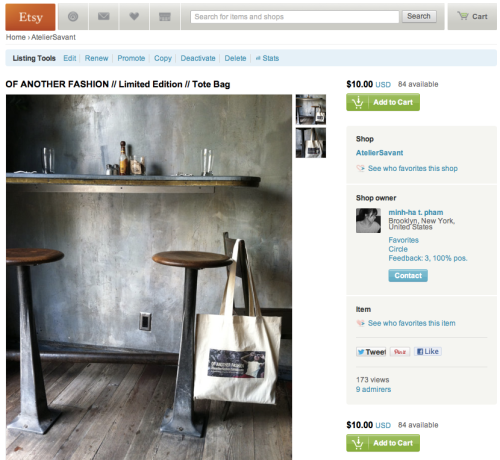 This month, I’ve been loving my friend Jessamyn Hatcher’s research, called “Deep Wearing: Affect, Materiality, and the Politics of Fashion.” Her exploration of the post-consumption life of clothing with regard to the environment, human emotion, and to the materiality of the garment itself is not only creative, her approach is smart and utterly elegant. A case in point is the Human-Textile Wellness Pop-Up Clinic she’s organized in Florence, Italy and in New York City. The Pop-Up Clinic is “an action research lab that documents people’s relationships to their clothing.” Put another way, it’s a space in which “the human-thing relationship” is reemphasized, reactivated, and restored through two significant, if undervalued, modes of fashion production: garment (re)construction and sartorial talk-story.
This month, I’ve been loving my friend Jessamyn Hatcher’s research, called “Deep Wearing: Affect, Materiality, and the Politics of Fashion.” Her exploration of the post-consumption life of clothing with regard to the environment, human emotion, and to the materiality of the garment itself is not only creative, her approach is smart and utterly elegant. A case in point is the Human-Textile Wellness Pop-Up Clinic she’s organized in Florence, Italy and in New York City. The Pop-Up Clinic is “an action research lab that documents people’s relationships to their clothing.” Put another way, it’s a space in which “the human-thing relationship” is reemphasized, reactivated, and restored through two significant, if undervalued, modes of fashion production: garment (re)construction and sartorial talk-story.
People are invited to visit the Pop-Up Clinic to repair, alter, or transform a garment (or some other textile). Along with this garment, she asks that you bring a “worn story” (a term Jessamyn borrows from Emily Spivack) about your “human-thing relationship”. Guests are asked to fill out an intake form that includes such questions as “How long have you and your garment been together?” and “How did you and your textile meet?” Unfortunately, I haven’t been able to make it out to the clinic – I was out of town for the last one – but her project has nonetheless stirred my intellectual, affective, and crafting sartorial imaginary. Truth be told, I don’t have much of a crafty sartorial self. Aside from the occasional pant or skirt hem and a canvas tote bag (a final project in a 3-week sewing class), I DO. NOT. SEW. Yet, after engaging with Jessamyn’s work several times this month, I bought a few yards of the most supple (faux) black leather I could afford, dug my seam ripper out of the junk drawer in my kitchen, and last night, I “reactivated” my relationship to a dress Mimi gave me that I’ve been on a “break” with for about 3 years.
I don’t think of myself as sentimental about things – which is ironic since OF ANOTHER FASHION demonstrates I’m clearly sentimental about other people’s things and their preservation of verbal and material fashions. But living in New York City where closet space is always at a premium might give some context to my attitude towards my own “stuff”. In fact, I don’t even have a closet – just a commercial-grade garment rack that barely fits in my bedroom. Yet, this dress stayed in my closet for years, even surviving a move back across the country.
There are a lot of elements of this dress that I love: it’s a shift dress with long sleeves, it’s bluish gray, it has an open split back and a sheer triangle-shaped cut-out panel that plummets down to the (or at least my) navel. What I love less about the dress is that the cut-out is a modesty panel covered with a grayish blue (as opposed to bluish gray, and yes, there’s a difference) chiffon. I wore the dress once on a dinner date and was happy to have it. Still, it wasn’t much later that I began planning ways to alter the dress. I’m just not a chiffon sort of person. I tend towards darker colors and heavier material (with regard to clothes). So I spent some time – a lot of time – studying the construction of the front panel and with great trepidation, started taking apart the dress. Once the chiffon was out, I hand-sewed the leather in place. Anyway, I’m pretty happy with it – at least the mistakes aren’t perceptible from the outside. I’d try it on for you but summer humidity has enveloped New York City, turning my apartment into a 2-bedroom sauna and this dress into a wool blanket. . . So what do you think?

 As most of you know, I have another online project called OF ANOTHER FASHION that began several years after Threadbared launched. The crowdsourced project is doing so well (over 3oo submissions and 104,000 followers) that I decided to celebrate this milestone with a tote bag. (In some respects, I favor tote bags over traditional handbags and shoulder bags for their practicality and easy stylishness. Yes, I just wrote that: “easy stylishness”. Whatevs. You know what I mean.)
As most of you know, I have another online project called OF ANOTHER FASHION that began several years after Threadbared launched. The crowdsourced project is doing so well (over 3oo submissions and 104,000 followers) that I decided to celebrate this milestone with a tote bag. (In some respects, I favor tote bags over traditional handbags and shoulder bags for their practicality and easy stylishness. Yes, I just wrote that: “easy stylishness”. Whatevs. You know what I mean.)












